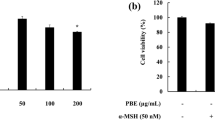Abstract
Zebrafish phosvitin-derived peptide Pt5, consisting of the C-terminal 55 residues of phosvitin, has been shown to have an antimicrobial-immunomodulatory activity comparable to phosvitin. Here, we showed clearly that Pt5 had the capacity to inhibit tyrosinase (TYR) activity and melanin biosynthesis, and this inhibition was independent of cell proliferation and cytotoxic effects. Incubation of fluorescein isothiocyanate (FITC)-labeled Pt5 with B16F10 melanoma cells revealed that Pt5 was localized in the cytoplasm of the cells. In addition, Pt5 inhibited the expression of TYR, tyrosinase-related protein-1 (TRP-1), tyrosinase-related protein-2 (TRP-2), and microphthalmia-associated transcription factor (MITF) in B16F10 melanoma cells and reduced the intracellular cyclic adenosine monophosphate (cAMP) concentration in the cells, but it did not affect the cellular contents of pERK1/2 and β-catenin, suggesting that Pt5 regulates melanin biosynthesis via cAMP signaling pathway rather than Wnt and MAPK pathways. Collectively, these data indicate that Pt5 has the potential to be used as a melanogenesis inhibitor in medical and cosmetic industry, a novel role ever reported.






Similar content being viewed by others
Abbreviations
- cAMP:
-
Cyclic adenosine monophosphate
- ERK:
-
Extracellular signal-regulated kinase
- MAPK:
-
Mitogen-activated protein kinase
- MITF:
-
Microphthalmia-associated transcription factor
- TRP:
-
Tyrosinase-related protein
- TYR:
-
Tyrosinase
References
Chang TS (2012) Natural melanogenesis inhibitors acting through the down-regulation of tyrosinase activity. Materials 5:1661–1685
Cho YK, Shin DS (2011) Ethyl-(4-hydroxyphenyl) oxamate sodium salt as a strong melanin biosynthesis inhibitor. J Korean Soc Appl Bi 54:66–72
Ding YC, Liu XM, Bu LZ, Li HY, Zhang SC (2012) Antimicrobial-immunomodulatory activities of zebrafish phosvitin-derived peptide Pt5. Peptides 37:309–313
Gilchrest BA, Eller MS (1999) DNA photodamage stimulates melanogenesis and other photoprotective responses. J Investig Dermatol Symp Proc 4:35–40
Goding CR (2000) Mitf from neural crest to melanoma: signal transduction and transcription in the melanocyte lineage. Genes Dev 14:1712–1728
Gupta SD, Masakapalli SK (2013) Mushroom tyrosinase inhibition activity of Aloe vera L. gel from different germplasms. Chin J Nat Medicines 11:616–620
Hearing VJ, Jimenez M (1987) Mammalian tyrosinase—the critical regulatory control point in melanocyte pigmentation. Int J Biochem 19:1141–1147
Hearing VJ, Korner AN, Paweiek JM (1982) New regulators of melanogenesis are associated with purified tyrosinase isozymes. J Invest Dermatol 79:16–18
Hodgkinson CA, Moore KJ, Nakayama A, Steingrimsson E, Copeland NG, Jenkins NA, Arnheiter H (1993) Mutations at the mouse microphthalmia locus are associated with defects in a gene encoding a novel basic-helix-loop-helix-zipper protein. Cell 74:395–404
Hoekstra HE (2006) Genetics, development and evolution of adaptive pigmentation in vertebrates. Heredity 97:222–234
Hu LL, Sun C, Luan J, Lu LL, Zhang SC (2015) Zebrafish phosvitin is an antioxidant with non-cytotoxic activity. Acta Bioch Bioph Sin 47:349–354
Hu LL, Sun C, Wang SN, Su F, Zhang SC (2013) Lipopolysaccharide neutralization by a novel peptide derived from phosvitin. Int J Biochem Cell 45:2622–2631
Huang HC, Chiu SH, Chang TM (2011) Inhibitory effect of [6]-gingerol on melanogenesis in B16F10 melanoma cells and a possible mechanism of action. Biosci Biotechnol Biochem 75:1067–1072
Ishikawa S, Yano Y, Arihara K, Itoh M (2004) Egg yolk phosvitin inhibits hydroxyl radical formation from the Fenton reaction. Biosci Biotechnol Biochem 68:1324–1331
Jang JY, Kim HN, Kim YR, Choi YH, Kim BW, Shin HK, Choi BT (2012) Aqueous fraction from Cuscuta japonica seed suppresses melanin synthesis through inhibition of the p 38 mitogen-activated protein kinase signaling pathway in B16F10 cells. J Ethnopharmacol 141:338–344
Jimbow K, Quevedo WC, Fitzpatrick TB, Szabo G (1976) Some aspects of melanin biology: 1950–1975. J Invest Dermatol 67:72–89
Jung S, Kim DH, Son JH, Nam K, Ahn DU, Jo C (2012) The functional property of egg yolk phosvitin as a melanogenesis inhibitor. Food Chem 135:993–998
Kato N, Sato S, Yamanaka A, Yamada H, Fuwa N, Nomura M (1998) Silk protein, sericin, inhibits lipid peroxidation and tyrosinase activity. Biosci Biotechnol Biochem 62:145–147
Kim YJ, Uyama H (2005) Tyrosinase inhibitors from natural and synthetic sources: structure, inhibition mechanism and perspective for the future. Cell Mol Life Sci 62:1707–1723
Kuzumaki T, Matsuda A, Wakamatsu K, Ito S, Ishikawa K (1993) Eumelanin biosynthesis is regulated by coordinate expression of tyrosinase and tyrosinase-related protein-1 genes. Exp Cel Res 207:33–40
Li H, Min YS, Park KC, Kim DS (2012) Inhibition of melanogenesis by Xanthium strumarium L. Biosci Biotechnol Biochem 76:767–771
Li ZJ, Zhang SC, Liu QH (2008) Vitellogenin functions as a multivalent pattern recognition receptor with an opsonic activity. PLoS One 3:e1940
Liu Y, Hong L, Kempf VR, Wakamatsu K, Ito S, Simon JD (2004) Ion-exchange and adsorption of Fe(III) by Sepia melanin. Pigment Cell Res 17:262–269
Maroñas O, Sochtig J, Phillips C, Carracedo A, Lareu MV (2015) The genetics of skin, hair and eye variation and its relevance to forensic pigmentation predictive tests. Forensic Sci 27:13–40
Ortonne JP (2012) Normal and abnormal skin color. Ann Dermatol Vener 139:73–77
Pillaiyar T, Manickam M, Jung SH (2015) Inhibitors of melanogenesis: a patent review (2009-2014). Expert Opin Ther Pat 25:775–788
Prota G, Hu DN, Vincensi MR, McCormick SA, Napolitano A (1998) Characterization of melanins in human irides and cultured uveal melanocytes from eyes of different colors. Exp Eye Res 67:293–299
Schurink M, van Berkel WJH, Wichers HJ, Boeriu CG (2012) Novel peptides with tyrosinase inhibitory activity. Peptides 28:485–495
Ubeid AA, Zhao LM, Wang Y, Hantash BM (2009) Short-sequence oligopeptides with inhibitory activity against mushroom and human tyrosinase. J Invest Dermatol 129:2242–2249
Vance KW, Goding CR (2004) The transcription network regulating melanocyte development and melanoma. Pigment Cell Res 17:318–325
Wang SH, Wang Y, Ma J, Ding YC, Zhang SC (2011) Phosvitin plays a critical role in the immunity of zebrafish embryos via acting as a pattern recognition receptor and an antimicrobial effector. J Biol Chem 286:22653–22664
Acknowledgments
This work was supported by the Natural Science Foundation of China (31372505) and in part by the Department of Science and Technology of Shandong Province (ZR2011CZ004).
Author information
Authors and Affiliations
Corresponding authors
Rights and permissions
About this article
Cite this article
Liu, YY., Su, XR., Liu, SS. et al. Zebrafish phosvitin-derived peptide Pt5 inhibits melanogenesis via cAMP pathway. Fish Physiol Biochem 43, 517–525 (2017). https://doi.org/10.1007/s10695-016-0306-3
Published:
Issue Date:
DOI: https://doi.org/10.1007/s10695-016-0306-3




